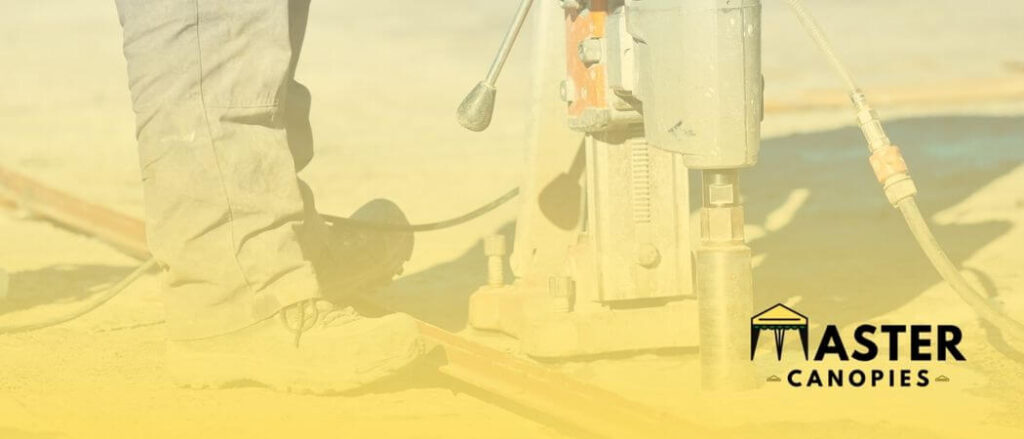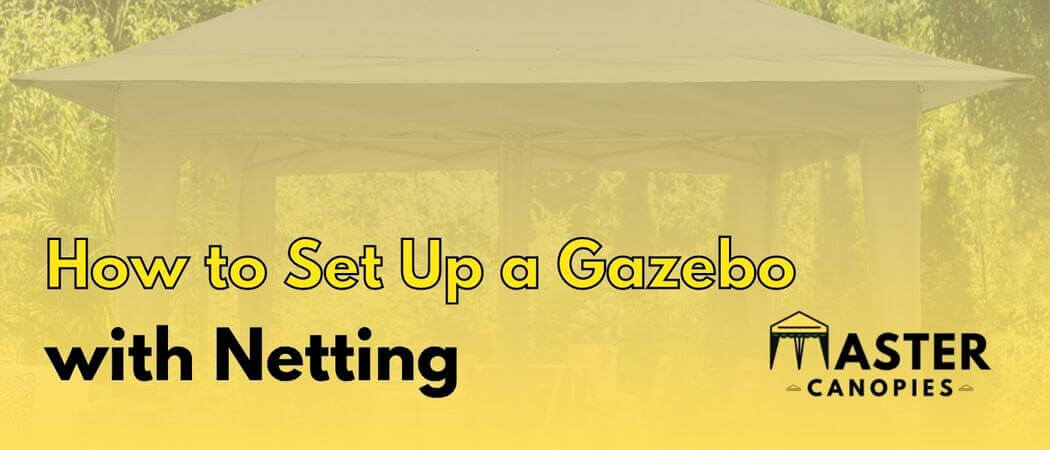
History of Gazebos: Who Invented the Gazebo?
History of Gazebos: Who Invented the Gazebo? Published October 6th, 2022 by Allen Campbell Let’s talk about the history of gazebos. Who invented the gazebo?
Published October 7th, 2022 by Allen Campbell

If you want to anchor a gazebo to concrete, you’ll need to use a few different methods. You can use anchor bolts, which you would drive into the ground using a hammer. Another option is to anchor the Gazebo without drilling holes by using different types of weights or anchors.
In this article, I will cover both methods so that you can make an informed decision about which one is best for you. Whichever method you choose, make sure that your gazebo is securely attached to the concrete so it doesn’t blow away in strong winds.
If you want to anchor a gazebo to concrete, the best way to do it is by drilling method. This involves creating holes in the concrete and then inserting anchors into those holes.
The anchors will keep the gazebo in place and prevent it from moving around or tipping over in high winds. Before moving on to the actual anchoring process, you need to gather the following materials:
Not everyone is comfortable with the idea of drilling holes in the concrete. Have no fear if you’re not a fan of drilling, there are other ways to secure your gazebo. Not only is this method easier, but it’s also less likely to damage your patio.
Mostly, the renters are not allowed to make any changes to the property, so they have to look for other options to secure the gazebo. If you’re in a similar situation and don’t want your Gazebos to blow away, here is one common method that will help you in anchoring the gazebo without drilling:
To begin with, you need to create some gazebo anchors. For this purpose, you need to find containers that are heavy enough to act as anchors. These can be large pots, buckets, or even planters. The containers should be big enough so that they can easily hold the gazebo down in strong winds.
Once you have found the right canopy/gazebo weights here, fill them up with either dirt, gravel, or sand. Make sure that the containers are filled to the brim so that they’re heavy enough to act as anchors. Now, take the containers and place them at the corners of your gazebo.
Using sand will give you the advantage of being able to adjust the placement of the containers easily, in case you need to move them. In the case of concrete, it will be difficult to move the containers once they’re in place.
Now that the containers are in place, you need to ensure they are secure so that high winds don’t blow them away. Additionally, you can also put each leg of the gazebo in a container. After that, you have the option of adding sand, gravel, or dirt to the container.
If you want to further secure the gazebo, you can also screw the legs into the containers. This will make it difficult for the gazebo to blow away in strong winds. The total weight of the gazebo, along with the containers, should be heavier than the force of the wind.
Mostly, 100-200 lbs are preferred for each leg to make the gazebo stay in its place. You can be creative with the containers by painting them or adding some decorative elements to them. Not only can you use them for anchoring, but you can also grow plants in them to liven up your patio.
If you are looking for an option to avoid drilling holes, then you can use straps to anchor your gazebo. This is a great way to secure the gazebo, without causing any damage to your deck. Also, using heavy anchors can put a lot of stress on your deck, which can eventually lead to the deck breaking. Now, let’s take a look at how you can use straps to anchor your gazebo:
First of all, you need to find a couple of strong and durable straps. The straps should be made of weather-resistant material so that they don’t get damaged in the rain or sun. If you want a strap that will last, I recommend a metal strap.
Once you have the straps, you need to attach them to the legs of the gazebo. Make sure that the straps are tightly fastened so that they don’t come loose. After that, you need to pass the straps under the deck boards and then over to the next leg. Do this for all the legs of the gazebo.
I would suggest you check the strength of the deck board before passing the strap over it. This is because the weight of the gazebo, plus the wind force, can cause the deck board to break.
So, it’s better to know the strength of the deck board in advance. Also, you can wrap the strap around 2 or 3 deck boards to distribute the weight evenly. It will also avoid breaking any single deck board.
n order to keep your Gazebo from being blown away by strong winds, there are a few things you can do. If you are working on concrete, you can drill holes and use concrete anchors to secure the Gazebo.
If you don’t want to drill holes, then you can use heavy containers by filling them with sand, dirt, or gravel. I have also mentioned how you can use straps to anchor if you are looking to secure the Gazebo on a deck.
When it comes to purchasing a gazebo, one of the most important considerations is wind resistance. Nobody wants their gazebo to go flying away the first time there’s a gust of wind! A sturdy gazebo should be able to withstand winds up to 60 mph.
However, if you have a cheaper or lower-quality gazebo, it may not be able to withstand as much wind. In general, it is best to avoid putting up a gazebo in extremely windy conditions, or at least make sure that the gazebo is properly secured. Otherwise, you run the risk of the gazebo collapsing and causing damage or injury.
If you’re looking for a way to hold down a gazebo, sandbags are a popular option. They are not too pricey, are easy to find, and can be filled with any available materials like sand, dirt, or rocks. The main downside of sandbags is that they can be fairly heavy, so if you’re planning on moving the gazebo around often, they may not be the best option.
Additionally, sandbags will only work if the gazebo is sitting on a flat surface; if there’s any chance of the gazebo tipping over, sandbags probably won’t do much good. Overall, sandbags can be a helpful way to hold down a gazebo, but they’re not perfect. If you want a longer-term solution, you should explore different choices.
Many people enjoy spending time outdoors in their gazebos, but high winds can make them unsafe. To help make your gazebo more wind-resistant, there are a few things you can do. First, make sure that the frame is securely anchored to the ground. If possible, use concrete footings or metal brackets to create a more solid foundation.
You should also add extra bracing to the frame and use Guy wires to help support the structure. Finally, choose wind-resistant materials for the roof and walls of your gazebo. Shingles or metal panels can help to deflect strong winds, and hurricane straps can also be used to secure the roof.

Allen is a full time writer at Mastercanopies.com and enjoys traveling around the United States and exploring nature. He enjoys writing about canopies as he believes they are extremely crucial in having a successful camping trip whether it be a trip to the beach, mountains, or the open plains.

History of Gazebos: Who Invented the Gazebo? Published October 6th, 2022 by Allen Campbell Let’s talk about the history of gazebos. Who invented the gazebo?

Best Gazebos for Winter: Top Picks Published October 5th, 2022 by Allen Campbell Although the thought of winter may send shivers down your spine, it

How to Set Up a Gazebo with Netting: Put Netting on Your Gazebo Published August 30th, 2022 by Allen Campbell Summer is in full swing,

Best 12’x 12′ Pop-Up Gazebos with Netting Published August 29th, 2022 by Allen Campbell Looking for the best 12×12 pop-up gazebos with netting? You’ve come

Best Pop-Up Gazebos with Walls: TOP PICKS Published August 25th, 2022 by Allen Campbell A gazebo is a great way to add some extra living

Will Gazebos Get Blown Away? How to Secure Your Gazebo Tent Published August 12th, 2022 by Allen Campbell Gazebos are a popular addition to yards

How Much are Gazebos? Gazebo Costs: Custom & Premade Prices Published August 12th, 2022 by Allen Campbell Making a gazebo tent is a great way

Palapa vs Gazebo? What are the Differences? Published August 4th, 2022 by Allen Campbell Whether you’re looking to add some extra shade and relaxation to

How Much Wind Can a Canopy Take? Published June 1st, 2022 by Allen Campbell When you need a little additional cover, a canopy tent might

Master Canopies is here to bring you the best canopies for the outdoors so that you can enjoy the fresh air without the gleaming and burning light of the sun.

Master Canopies is here to bring you the best canopies for the outdoors so that you can enjoy the fresh air without the gleaming and burning light of the sun. As an Amazon Associate, we earn from qualifying purchases.